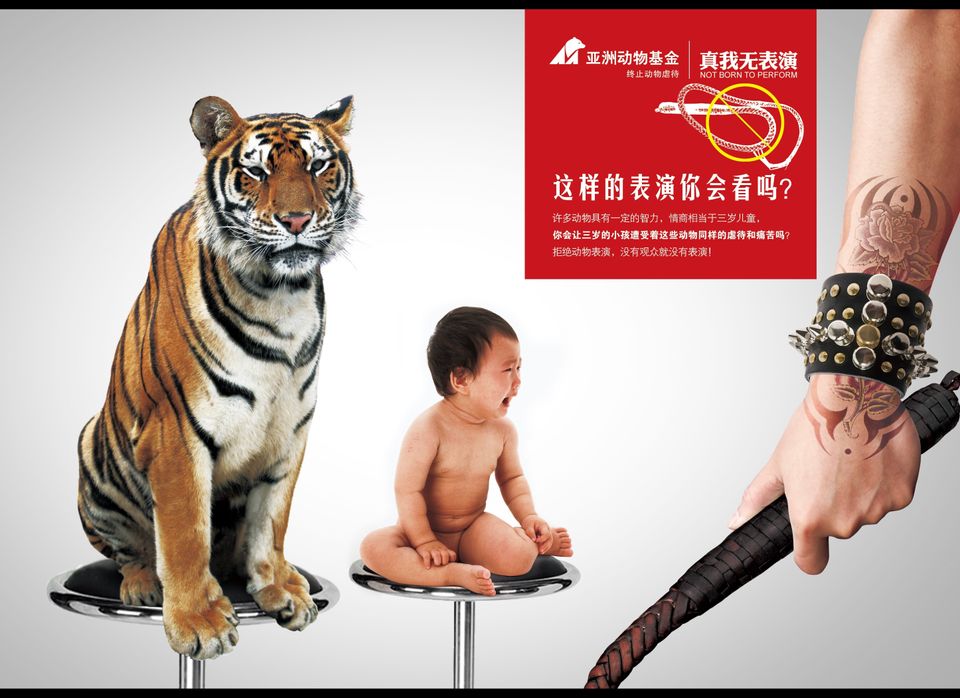One of the most tragic scenes imaginable is that of majestic wild animals being abused; terrible scenes of de-toothed and de-clawed tigers and lions being hurt and forced to perform degrading tricks for the so-called entertainment of the public. These big cats are whipped and goaded to pose, opening toothless mouths, or jumping, terrified, through hoops ringed with flames. Monkeys are dressed in garish clothes and smacked by trainers before they reluctantly ride bikes or horses. Bears wear brightly colored skirts and are forced to stand and skip with ropes, before being punched -- hard in the face -- when they fail. In China, we have documented these and countless other horrible spectacles for decades.
In the past few years, however, some extraordinary progress has been seen. This is as the result of local welfare groups, and the public, now questioning the welfare of the animals concerned, and the authorities taking action to wind these performances down.
Just recently, in Jinan, the capital city of Shandong province, the authorities made the startling decision to end what had become an annual festival. Just before the Jinan Animal Carnival Festival was due to start, an order was made to cancel it.
The event was set to go-ahead despite the fact that in 2010, the Ministry of Housing and Urban-Rural Development (MHURD) announced new regulations to stop all kinds of animal performance. This was followed up earlier this year with a comprehensive paper issued by the Chinese government, "The Development Outline of Chinese Zoos" that further clarified the ban.
Sadly, many facilities simply ignored the regulations, and the Jinan Bureau of Parks and Woods had sanctioned this particular event to go ahead, which would see animal performances up to three times a day for nearly three weeks.
Animals Asia was among concerned animal protection organizations that posted objections to the proposed event on its social media platforms. With momentum building online, MHURD was deluged with calls from concerned citizens, and an order was finally issued to the Jinan authorities to cancel the event. There was no doubt in anyone's mind that pressure from animal lovers across the country had seen the cancellation of the festival, in another victory for China's rapidly escalating animal welfare movement. What is equally remarkable is that evidence is coming to light showing that those facilities scrapping animal performances are actually seeing an increase in attendance in China. Earlier this year, the Nanjing Zoo announced that, since banning such performances and switching emphasis instead to environmental awareness and education, visitor numbers have increased.
The increased investment in education, and a switch to a more environmentally conscious approach was confirmed by the Education Department Head of Nanjing Zoo, Mdm. Bayali, saying: "We stopped animal performances in March 2011 but increased our conservation education activities and publicity. The investment on conservation education went up from tens of thousand to 800,000 RMB, meanwhile, we put greater effort into group visitor marketing, guiding the public, especially the group visitors, to understand the cruelty behind animal performance correctly and rationally." The zoo has since enjoyed its highest visitor numbers in five years.
Similarly, when Animals Asia recently launched our competition for the best images to use as posters to protest against animal performances, we were overwhelmed with the response. Receiving over 2,153 entries, the judges were amazed -- both with the talent and with the compassion of those who designed such emotive, intelligent art.
With the theme "Not born to perform", many of the animals in the posters were rightly shown as having needs and emotions as profound as humans, and yet were simply exploited for spectator "fun." Images showed the tear-stained faces of shackled elephants, and pictures depicting whips, sticks, electric prods, and the instruments of torture used in training, with heart wrenching titles such as "No cheers, no abuse", and "King or clown?"
Many of the posters are now displayed on billboards, and in lightboxes across the country in subways and railway stations, and show an obvious empathy for the plight of abused and humiliated animals in the performance ring.
This is nothing short of remarkable -- especially for a country that has for so long been considered synonymous with animal cruelty, rather than animal welfare. Over the years, we have both watched and assisted as creative, intelligent groups are no longer content to tolerate cruelty and abuse, and are taking brave and dynamic steps to end it.
Side by side, surprisingly perhaps to the reader, authorities in many provinces and towns are actively supporting this movement. Today, they recognize and promote the progress of social harmony when both people and animals are leading healthier, happier lives.
Make no mistake that change is taking place, with the animal welfare movement in modern China going from strength to strength in the hearts, minds and actions of a new generation of activists -- and the authorities too playing the most profound part of that change.
